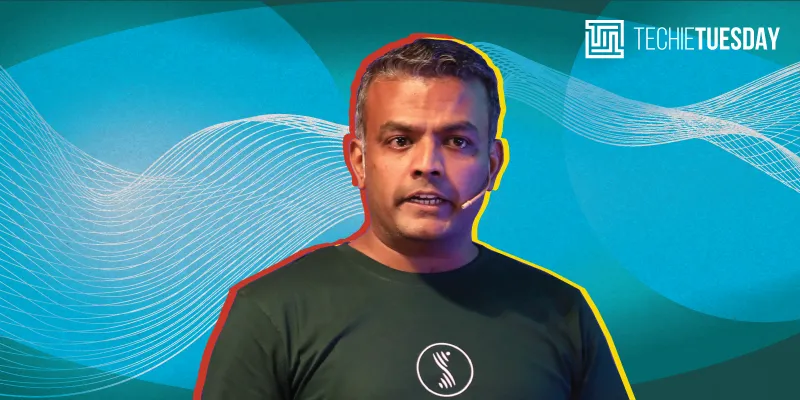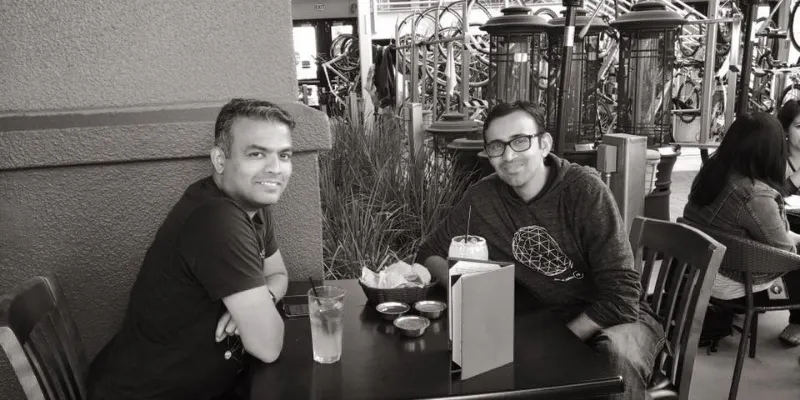[Techie Tuesday] From selling his startup to Facebook to building ‘the mother of Alexa’ - Kumar Rangarajan’s journey
This week on Techie Tuesday, we feature Kumar Rangarajan, ex-CEO of Little Eye Labs, who had Facebook telling him his product performs better than their own performance monitoring tools for Android apps.
If there is one thing Alexa users have in common, it is patience. As diligent and careful as one tries to be with their input voices, the output voice from Amazon’s virtual assistant always leaves some dissatisfaction.
“Instead of building a new Alexa skill, why not bring it into an existing experience and make that experience significantly better? That was our reimagination and that’s why we built Slang Labs, a platform to quickly build voice augmented experiences,” Kumar Rangarajan, Co-founder of Slang Labs, told YourStory during a Future of Work conference.
However, Kumar is neither a CTO nor a geek. He calls himself an obsessive dictator at Slang Labs because he says it sounds relaxing and not-so-serious.
Having his career revolve around acquisitions, Kumar sees that his life comes full circle, once every five years.

After selling his previous startup, Little Eye Labs, to Facebook (which was the company’s first India-acquisition) in 2014, Kumar co-founded Slang Labs in 2017. The startup develops augmented voice experiences for users, through which they can command their devices to perform actions, without having to touch the screen.
In a conversation with YourStory, Kumar Rangarajan, Co-founder of Slang Labs, talks about his love for programming during college days, his early stint at GE and HP, and what made him take the entrepreneurial plunge with Little Eye Labs and later Slang Labs.
Strong roots
Hailing from a middle-class family, Kumar’s father was working with the electricity board in Tamil Nadu, and his mother was at the Accountant General’s office.
Kumar says his father was someone who would defy the mundane and do things differently. He was an open rebel who would do things ahead of his time, and ensured that his family travelled around enough. And his mother was religious and disciplined. Kumar says the combination of traits his parents possessed compelled him to have a free hand in his pursuits but in a controlled fashion.
“Our family also followed an early-adopter curve. We were one of the first families to buy a colour TV and a washing machine in our communities. Though we did not have a lot of money to spend, we did not try to follow what other families did, but whatever best we could with what we had,” says Kumar.
And like most science and technology students, Kumar’s first tryst with programming was in his school’s computer lab, where he executed C and C++ programs.
But his real adoration with programming started in his third year of college when he immersed himself into Pascal programming’s books. An average student until then, Pascal soon became Kumar’s obsession.
“It was a completely deep and maddening love. Something inside flipped, and it was like a whole new world opened up in front of me. I would carry that book with me everywhere, eat with it and sleep with the book under my pillow. From my third year onwards, I became a nerdy guy, who would passionately argue with my professors,” says Kumar.
He studied Computer Science Engineering from Chennai’s Anna University (92-96 batch), and soon joined GE Medical Systems as a software engineer after he graduated in 1996.
A prospective mid-life crisis
Kumar worked at GE for two years, until 1998, and got along with his then-manager-cum-mentor Anantharaman. At GE, he was working on nuclear imaging for GEnie. While at it, he also made enhancements to GEnie’s UI.
After Anantharaman moved to HP, Kumar followed cue and joined the same company and worked with the compiler and tools division. At HP, Kumar was with the Linker team and led the project on 32 bit UX PA-RISC system. This went on for two years and Kumar quit HP in 2000.

At TechSparks 2012.
He then joined San Jose-based Rational Software in 2000, which developed software for application development. A year later, he moved to the company’s Cupertino office.
After returning to Bengaluru in 2003, he got married. A year later in 2003 Rational Software was acquired by IBM.
Kumar was a part of the acquisition, and he worked on the same product line at IBM where he met another mentor of his - Pankaj Kulkarni. When Pankaj moved to S7 software solutions, a startup that was in the software migration industry, Kumar also joined him in 2007.
With a lower paycheck than at IBM, Kumar joined S7 as a senior architect, to manage various projects, at the age of 32.
“Working at a larger company deprived me of my purpose, and it was definitely a mid-life crisis after IBM. I wanted to work with a smaller team to see the end-to-end impact closely,” he says.
And this mid-life crisis, as he calls it, led him to start thinking of starting up.
The entrepreneurial flight
Around 2010, at the wedding of Slang Labs Co-founder Giridhar Murthy, whom Kumar met at IBM, the talk about starting up came up.
This was also then time when Bengaluru-based S7 Software was acquired by Sunnyvale-based Blue Coat Systems, and Kumar was heading the engineering team at the latter.
“We heard that IBM was going to sell off the Purify+product line that we worked on at Rational Software. We naively wanted to buy it and start out our own company with it. But we realised later it was still making $25 million revenue per year. But the bug has been bitten. We wanted to build our own Purify+ like product."
They went through a series of different ideas, even attempting to make India’s Netflix. The team focused on their strengths (they were all developers) and looked to build a product useful to the new generation.
After much deliberation, with tens of ideas for the startup, Kumar and Giridhar decided to come up with a tool for Android Apps that would monitor and analyse their performance. And in April 2012, Kumar quit his job at Blue Coat Systems.
Kumar’s entrepreneurial dream finally took wings. Along with Satyam Kandula, Lakshman Kakkirala and Giridhar Murthy, Kumar started Little Eye Labs. The team invested Rs 10 lakh each from their personal savings with a rule that they would not take any salary for two years.
“If mobile penetration was one thing, the penetration for mobile apps and the standards that were set made the market fiercely competitive. App developers needed to be at their best,” says Kumar.
The team developed a first-of-its-kind performance analysis tool, which generates not just data, but also a great deal of context around the data. This combination made analytics and the consequent action steps rather easier and more meaningful.
How Facebook happened
Meanwhile, Kumar was actively involved in different Android-focused events and tech conferences in Bengaluru and Delhi, taking conversations around Little Eye Labs a step up from product-centric talks to domain-specific talks.

Kumar with Anand Chandrasekaran, ex-CPO at Snapdeal and ex-Director at Facebook Messenger, in California.
Little Eye Labs was also part of the GSF Accelerator, which got the team on a world tour, and Kumar reached the Android meetup in London.
“Someone from Facebook and Google had come there, whose contacts we took for further connection. After the product was at its best, we contacted them, and they got us connected with the developer relationships team in the US,” recalls Kumar.
At the Google IO event in 2013, where they were given a both to officially exhibit their product, they created leader board comparing various apps and their performance scores.
"Facebook had a bad score, and when the Facebook engineers visited the booth, they realised that the tool could be useful to them. Impressed by its simplicity, Facebook took the conversation further and acquired us in 2014," says Kumar.
Kumar then moved to Facebook’s Menlo Park headquarters in California and worked with the tech giant for three years. He was working on various performance tools and the corresponding products, and how they could integrate with each other. Soon, Kumar was working with the Messenger team and the AI-bot M. But wanting to start up again, he and Giridhar Murthy quit Facebook and returned to India in 2017.
Building a future for India
After having his hiccups with Amazon’s Alexa, Kumar set his eyes on a better performing voice-to-action SDK (software development kit) that could solely run commands with voice, without having to use a finger. And this led to the birth of Slang Labs. He started it with Giridhar Murthy and Sathish Chandra Gupta.
In short, Kumar is now developing an app that would obey your commands with voice.
“Voice is great as an input mechanism but sucks as an output mechanism. And we wanted the product to be a mixture of voice and visuals, because apps are really great for a visual experience,” he says.
Kumar wanted to make this experience even better by removing the burden of language translation from the apps, so that Indian vernacular users can just talk their native tongues.
At Slang Labs, he is now working on building APIs that would automate the translation and simply jump to actions.
Slang Labs was shortlisted to be a part of Tech30 at TechSparks 2018, which is YourStory’s flagship annual startup and tech summit.
Kumar also credits Shradha Sharma, CEO of YourStory, for recognising Little Eye Labs at TechSparks in 2012
(Edited by Megha Reddy)


![[Techie Tuesday] From selling his startup to Facebook to building ‘the mother of Alexa’ - Kumar Rangarajan’s journey](https://images.yourstory.com/cs/2/730b5070-2d6c-11e9-aa97-9329348d4c3e/Techie-tuesday---kumar-rangarajan-800x4001566827494333.png?mode=crop&crop=faces&ar=2%3A1&format=auto&w=1920&q=75)
![[Techie Tuesday] How Razorpay’s Shashank Kumar built India’s first online payment gateway for s...](https://images.yourstory.com/cs/2/730b5070-2d6c-11e9-aa97-9329348d4c3e/Shashank_Kumar_TechieTuesday-011564425520224.png?fm=png&auto=format&h=100&w=100&crop=entropy&fit=crop)
1550201760493.jpg?fm=png&auto=format&h=100&w=100&crop=entropy&fit=crop)
![[Techie Tuesday] From building India’s first supercomputer to finding a non-invasive way of det...](https://images.yourstory.com/cs/2/a9efa9c0-2dd9-11e9-adc5-2d913c55075e/Techie-Tuesday-Geetha-Manjunath1560780626901.png?fm=png&auto=format&h=100&w=100&crop=entropy&fit=crop)




